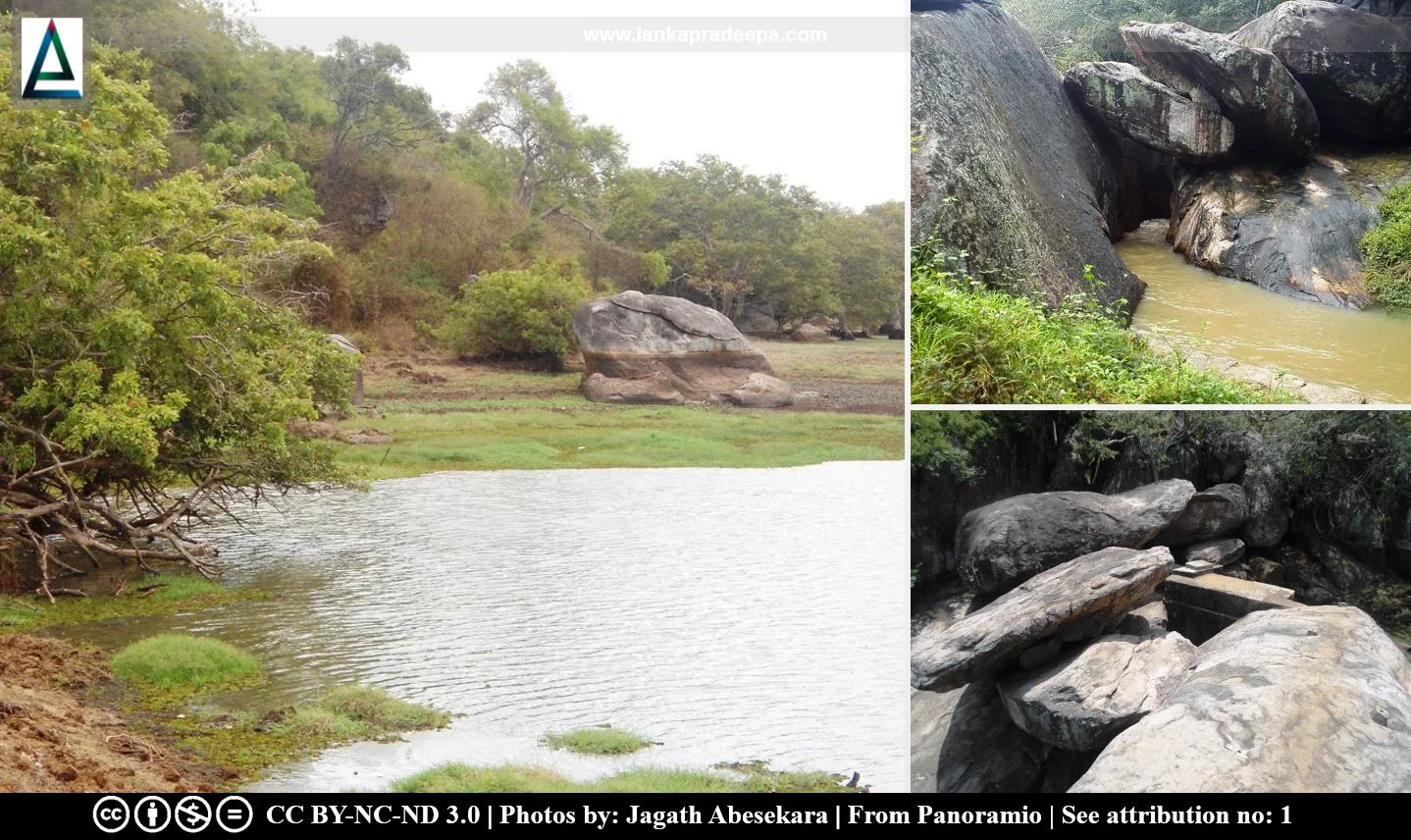
|
Erupothana Wewa and natural sluice outlet (right) |
Erupothana Wewa (Sinhala: ඒරුපොතාන වැව) is a reservoir in Vavuniya District, Sri Lanka. It is surrounded by Mamaduwa Wewa to the northwest, Mahakachchikodiya Wewa to the southwest, and Kimbulagala Archaeological Site to the northeast. The ruins of ancient Erupothana Buddhist Monastery are located at the northen edge of this tank. The maintenance of this archaeological site is currently managed by the Vavuniya Regional Archaeological Office.
Buddhist Monastic Complex
Belonging to the Mahakachchakkodiya Grama Niladhari Division under the Vavuniya South Divisional Secretariat, the Erupothana monastic site is located approximately 17 km along the B442 road starts from Vavuniya towards Mamaduwa and Weli Oya. The monastic complex is established using natural rock caves on a rugged rocky outcrop. The earli-Brahmi inscriptions that are found engraved under the drip-ledges of these caves date back to the pre-Christian era (Paranavitana, 1970). These inscriptions record the donation of the caves to the community of Buddhist monks indicating that this site was an ancient Buddhist monastery since the early part of the Anuradhapura Period.
Period: 3rd century B.C.-1st century A.D.
Script: Early Brahmi
Language: Old Sinhala
Transcription: Parumaka-Nadika-putasha parumaka-Mitasha lene agata-anagata-catu-disha-shagasha dine
Translation: The cave of the chief Mitta, son of the chief Nandika, [is given] to the Sangha of the four quarters, present and absent.
Note: The name "Parumaka Nadika," identified as Nandimithra Senapathi, one of King Dutugemunu's (161-137 B.C.) ten great warriors, according to historical chronicles and folklore.
References: Paranavitana, 1970., Paranavitana & Godakumbura, 1963
Spread across an area of about 4 km, the Erupothana archaeological site consists of more than 100 of caves, natural and man-made ponds, remains of ancient structures, cave temples with stone walls, and ruins of six dilapidated Stupas. In one of the cave temples, a broken Buddha statue can be observed, suggesting its use as a meditation retreat for monks.
Evidence of an ancient settlement associated with this monastic complex are also identified near the Erupothana reservoir. Archaeological evidence suggests that this reservoir belongs to the same historical period of the monastic complex. Its sluice gate was constructed using a natural rock formation as found in Sorabora Wewa in Mahiyanganaya.
Related Posts
Read Also
References
Books
1) Medhananda, E., 2003. Pacheena passa - Uttara passa: Negenahira palata ha uturu palate Sinhala bauddha urumaya (In Sinhala). Dayawansa Jayakody & Company. Colombo. ISBN: 978-955-686-112-9. pp.509-510.
2) Paranavitana, S.; Godakumbura, C.E., 1963. Epigraphia Zeylanica: being lithic and other inscription of Ceylon (Vol. 5, Part II). Government Press, Ceylon, for the Archaeological Department. pp.237-239,251.
3) Paranavitana, S., 1970. Inscriptions of Ceylon: Volume I: Early Brahmi Inscriptions. Department of Archaeology Ceylon. pp.26-27.
Location Map
Dynamic Google Map
Attribution
To Whom
Erupothana tank, Erupothana tank and Erupothana tank natural sluice outlet by Jagath Abesekara are licensed under CC BY-NC-ND 3.0

